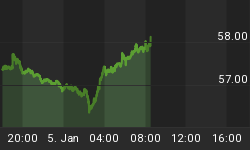One of the advantages our paid subscribers have, is that they get to see short term and long term Liquidity injection flows from M3 and Foreign sources. (Once again, today's chart is a courtesy posting of one of our private charts.)
Why is that important?
Because one of the main tools that Fed has in affecting the economy is the use of M3 Liquidity. When the money supply is expanded, it has spurs new growth and spending, and the rate of economic growth increases. Because of this, it is an effective tool for the Fed to use in order to avert the recession that everyone was expecting.
Many of the large New York Investment houses have built this factor into their investment models. So, when Long Term Liquidity is in Expansion, they accumulate stocks ... when it is in contraction, they sell and go into distribution.
This can be seen in our Long Term Liquidity chart below. Note that when Liquidity continues in an expansionary trend, the stock market rallies up. Once the expansionary trend breaks its support line, Liquidity starts to decelerate and move into contraction. When this happens, the stock market moves into a correction as you can see below.
With housing taking a dive, that will eliminate the possibility of home equity loans for consumers. This is important, because much of the market's rise and consumer spending since 2003 was provided by consumers tapping the equity in their homes. With falling housing prices, excess house-to-mortgage values are not there for banks to issue home equity loans on. If home equity loans diminish, then over time, consumer spending will drop.
The Fed's fear is that reduced consumer spending could guarantee a recession. Prior Fed thinking was to increase M3 during a recession and stimulate the economy back into action. Current thinking is "why wait, and why not increase M3 before a recession takes hold so we can by pass a recession?"
For that reason, M3 inflows and injections have been huge as seen on the chart. And, like all M3 expansions, the stock market floats up with expanding liquidity. This is the first Fed instance I know of where the Fed has been trying to be pro-active. But, according to one Fund Manager, that may prove to be a big problem ... see his commentary below.

Why would the Fed want to keep pushing M3 injections?
I had a very fascinating discussion with a Fund Manager yesterday who had an interesting perspective on the Fed and the economy, so I will share it with you today.
Basically, John had this opinion:
"Corporations are doing well and are sitting on massive amounts of cash. Consumer spending is heading towards a big problem in spending patterns as the housing values deteriorate. In the recent past, most of consumer spending was not generated by wage gains, but by housing price inflation and equity loans. That spending source is in real trouble now.
Bernanke's battle has two focuses. One is to stimulate the economy with larger amounts of M3 so that the yield curve stays at least flat and moving in a positive direction. The other focus is to induce spending which will drive the economy forward and avert a recession. But, he is not going to be able to stimulate consumers with the housing problem, so the only other alternative he has is to stimulate corporations to spend. The theory here is, if corporations spend enough, then there will be an expansion in growth and that would spill over into the employment wage side.
Theoretically, that is a correct assumption, but in real life practice, it is flawed. I love football, so let me give you an analogy. The fullback of the leading team is going into the playoffs. He's been sick, so he is not up to par, but the coach is counting on him to be a deciding factor in the game. After an hour of play he tells the coach that he is exhausted and weak. The coach gives him a steroid and tells him to get back in the game. He plays exceptionally well, but fatigues again after 40 minutes. This time the coach gives him double the amount of steroids, and tells him to get back into the game. He's now pushing his body beyond the natural limits of his heart and sustains a major heart attack and is out of the game for the rest of the season.
My point here, is that M3 injections are economic steroid injections. There is a point that, if continued, the injections will be over the natural limits of the markets and the over stimulation will result in a market failure. I think Bernanke is brilliant, but I don't think he is looking at the degree of abnormality of his push to drive up corporate spending. If he is blind to this element, he won't know when he has over medicated the economy and the market with M3. Maybe he is aware of it, but so far I don't believe it because of his incessant push without a pause. Even the economy and the stock markets need healthy pauses and pullbacks to reenergize on their own."
Please Note: We do not issue Buy or Sell timing recommendations on these Free daily update pages. I hope you understand, that in fairness, our Buy/Sell recommendations and advanced market Models are only available to our paid subscribers on a password required basis. Membership information















